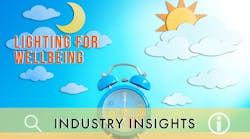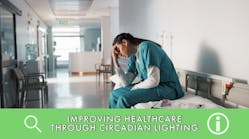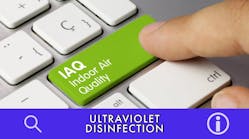INDUSTRY INSIGHTS | Bringing circadian rhythm lighting and quantum dots together to advance wellbeing
As an industrial designer working with quantum dots for lighting applications, I have seen firsthand the transformative power of advanced lighting technology. It has the potential to revolutionize a wide variety of industries, from aerospace to senior care.
Whether you are a lighting designer, architect, or industry professional, there is valuable information to be gained on how to harness the power of light to enhance human health and performance. In a series of articles, I’d like to share some of the experiences and insights I’ve gained from working in key areas where lighting technology can make an impact on human well-being.
A brief backgrounder
In 2017, the Nobel Prize for Medicine and Physiology highlighted the critical role of circadian rhythms in our health. My initial work with QDs focused on their application in aerospace, yacht, and automotive glass applications. These advanced materials offer significant advantages in terms of color accuracy and energy efficiency. The recognition of circadian research inspired me to investigate using QDs to emulate natural light. Their unique properties make them ideal for creating systems that mimic the sun’s natural light spectrum. Notoriety as a result of the 2023 Nobel Prize in Chemistry has also positioned QDs as a revolutionary lighting technology.
It’s important to demonstrate the real-world applications of circadian lighting solutions across a variety of projects. Circadian-effective lighting can enhance productivity, health, and well-being, while also showing a financial return on investment that customers can use.
Now with 12 years of experience working with quantum dots for lighting, I have gained key insights from various projects where I have consulted, scoped, or manufactured and sold-in lighting. Results from such projects have even shaped solutions development at Nano-Lit Technologies.
Because there are so many fields to explore, I need your help. Once I’ve introduced the key topics, I’d like readers to vote for the top three areas you want to hear about. So, read on, and then let me know in the poll below what areas you’d most like to explore further.
Circadian topics
To kick off, brief descriptions of circadian lighting projects and initiatives I’ve worked on. As noted earlier, I intend to write about the applications in depth, using anonymized case studies to highlight relevant research and white papers, illustrating what the studies allow our partners to communicate with customers from a research-backed, science-based perspective.
Aerospace/aviation. Aerospace applications reveal the importance of lighting in high-stress, high-stakes environments. Circadian rhythm lighting aims to enhance pilot alertness and reduce fatigue, ultimately improving safety and performance, as well as helping to reduce passenger jet lag.
Automotive. In the automotive industry, optimizing in-car lighting for drivers and passengers can significantly improve comfort and alertness. Dynamic lighting solutions have potential in self-driving cars, which may become a third living and working space.
Commercial office spaces. In commercial offices, where employees often work long hours, implementing circadian rhythm lighting strategies can reduce stress and increase productivity.
Education. Lighting in educational settings can influence student performance and well-being. Through a remote community project, we have developed lighting solutions that support optimal learning environments by aligning with students’ natural circadian rhythms.
Firehouse/fire apparatus. Firefighters have irregular schedules and often need to be alert at a moment’s notice and have the ability to quickly return to sleep. Within the firehouse and even in fire trucks, circadian-effective lighting can enhance alertness and reaction times when needed — crucial for the safety and efficiency of emergency responders — and support their ability to achieve proper rest to recover.
Healthcare settings. Intensive care unit patients’ recovery can be significantly influenced by their environment. In memory care, maintaining a consistent circadian rhythm is essential to support cognitive function and reduce symptoms associated with memory disorders, while seniors in conventional residential care homes can enjoy improved quality of life under lighting systems that mimic natural light patterns.
Industrial environments. Industries such as mining and port logistics demand long hours in challenging environments. For example, mining involves long hours in dark, confined spaces and traveling for workers, whereas port control rooms operate around the clock, requiring staff to stay alert during long shifts. Effective circadian lighting can help improve focus and safety by regulating workers’ sleep-wake cycles as well as mitigate some of the negative side effects of working in these environments.
Space and subsea applications. Although they are quite different, both space vehicles and submarines pose similar challenges with their lack of natural light and confined environments. Specialized lighting systems can help to maintain crew members’ circadian rhythms, alertness, and well-being in these uniquely restrictive environments.
Conclusion
Beyond case studies, other topics for discovery include setting industry benchmarks for health-focused lighting solutions and demonstrating the financial viability of implementing advanced lighting solutions. We have ROI calculators available to help stakeholders understand the long-term benefits and savings associated with circadian rhythm lighting. Nano-Lit's circadian lighting is installed at the WELL offices and was used to set the lighting standards for Platinum v2 for WELL and LEED. These activities have helped to shape guidelines that ensure circadian rhythm lighting is implemented appropriately.
As we continue to understand the profound impact of lighting on our well-being, it's clear that innovations in circadian systems are vital to our daily lives. I am excited to share the experiences and evidence of this technology moving from potential to essential.
Sarah Morgan | Founder and CEO, Nano-Lit Technologies
SARAH MORGAN is an industrial designer with 12 years of experience in the lighting industry, specializing in quantum dots and circadian rhythm lighting, and founded Nano-Lit Technologies to develop evidence-based lighting systems. Morgan has worked on projects across various sectors, has developed IES presentations, and continues to educate various audiences on light, quantum dots, and circadian rhythms. Connect with Sarah Morgan on LinkedIn for more insights and updates.









![The DesignLights Consortium continues to make progress in shifting outdoor lighting products and implementation practices toward a more restrained and thoughtful strategy. [Image does not represent a DLC qualified fixture.] The DesignLights Consortium continues to make progress in shifting outdoor lighting products and implementation practices toward a more restrained and thoughtful strategy. [Image does not represent a DLC qualified fixture.]](https://img.ledsmagazine.com/files/base/ebm/leds/image/2024/08/66be810888ae93f656446f61-dreamstime_m_265700653.png?auto=format,compress&fit=&q=45&h=139&height=139&w=250&width=250)
